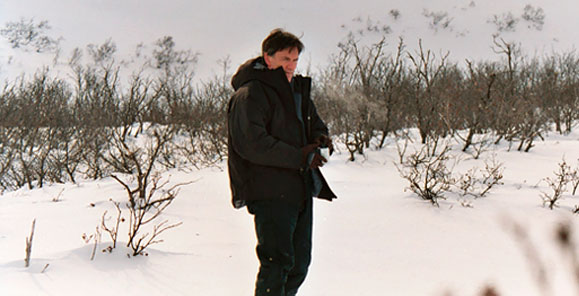
2008
The Vision: Uniting Prose and Song
“The idea for Wild Animus germinated while I was at Berkeley in the late 60s,” Rich says. “It started with an identification with wild things—the ram and his wolves. There were some attempts to merge serious writing with popular music, at the time, by artists like Jim Morrison and Don Van Vliet. I dreamed of the search for deeper truths in a wild setting, using words and music, married in new ways.”
“I wondered if it might be possible to bring the Bardic tradition into the modern era . . .”

“The Dyin’ Crapshooter’s Blues”
Rich encountered the classical stories told in song—The Epic of Gilgamesh, Homer’s works, and the medieval romances. He began to experiment with the long-story form, using music in a modern setting. Then he came across Blind Willie McTell’s “The Dyin’ Crapshooter’s Blues” and an idea took shape: “Blind Willie’s song gives you the story of a man in his last hours. You’re at his bedside, and beside the wagon taking him to the graveyard, and you experience a panorama of emotion—pathos, futility, wry humor—as the story unfolds. Instead of using a repeated melody with a fixed meter and tempo, Willie took a variety of melodies, each with its own meter and tempo, and stitched them together. The ‘logic’ for the changes came from the story itself. The clashes were jarring, but each moment was accessible, and the violence of the construction gave it a special power. I wondered if it might be possible to bring the Bardic tradition into the modern era by using a similar approach.” Rich fell in love with the idea. “I thought it might be a way to experience a story more fully, more deeply.”
“The setting for my journey was the wilderness of Alaska. I had to get there, to act out the mythos germinating in my head.”
A Journey of Discovery
My story—the story I wanted to tell—was a journey of discovery,” Rich recalls. “The setting for my journey was the wilderness of Alaska. I had to get there, to act out the mythos germinating in my head. But that wasn’t so easy. When I graduated from Berkeley, I didn’t have a nickel. I worked on the music and first draft of Wild Animus for about eight months, and sold all my stuff—stereo, books, records, furniture. Then I got a job digging ditches for BART. Then I ran printing presses. Then I sold printing presses. When I wasn’t working, I was writing.”
He didn’t want to return to school, but he was considering that when a friend introduced him to an old raconteur who worked for a computer company named Univac. “Al had been an English lit major at Berkeley, like myself, and worked for the Disney organization back in the Peter Pan days. He offered me a job.”
Jumping Off
“It was a magical opportunity,” Rich says. “Not only did I get a paycheck, but it meant relocating to Seattle, the jumping-off point for Alaska‚ the landscape for Wild Animus and my creative dreams.” Two years later, he traveled there. He would return frequently over the next 30 years.
Rich set Wild Animus on Mt. Wrangell. “I negotiated leaves with my employers, in some instances as long as a month or two. Between jobs, I took as much time off as I could, exhausting my savings. One summer, when airfare rates were low, I flew to Alaska every weekend. I’d leave Friday afternoon, return on a red-eye Sunday night, and drive from the airport to work Monday morning. When I started my own business, it was easier.”
As he prepared for solo trips into the backcountry, scientists asked him to collect information for them. “I ended up doing the first plant collection on Mt. Wrangell, and the first bird accounting. I collected butterflies for the Smithsonian and spiders for the American Museum of Natural History. There were scientific papers that came out of it. I found what appeared to be a new species of plant and used that in the novel.”

“Ultimately, I came up with the idea of uniting prose with song, using the written word for detail, and allowing what was sung to be more elliptical and suggestive, following the emotional trajectory and pace of the story.”

Discouraged and Despairing
But to call these experiences “research” puts a more pragmatic gloss on it than was really the case. “I disappeared into Wild Animus. I lost sight of words and music and everything else. The insanity that possesses Ransom in my novel is drawn from life. I had a perceptual breakthrough—something earthshaking. But it took years for me to understand it. And it wasn’t until I could intellectualize what had happened to me that I was able to finish the story.”
It was in the early 80s that Wild Animus stalled. “There’s a copy of Alaska Geographic from that era with a story about an ascent of Mt. Wrangell. It’s written by a lunatic named Ransom Saltmarch, who is working on a novel named Wild Animus.” The novel was supposed to be published the following year. “I was discouraged and despairing,” Rich says. “The story was as much a paradox as the life I was leading. I couldn’t understand it, and neither would anyone else.”
Rich turned to other projects. During the years that followed, he had two jobs: He would put in a day’s work in the computer industry and then spend evenings, weekends and spare hours working on his words and music.
A Breakthrough
After running a couple of computer communications companies, he became a venture capitalist. “The progress on my newer literary projects restored some of my confidence and enthusiasm.” By 2000, he was close to completion on one of these.
Then he had a breakthrough on Wild Animus: “The core idea blazed up before me, and I realized how the story should be told.” He set everything else aside. “This was my first project, and it seemed right that it should be the first to see the light of day.” He completed the novel in two years and started production on the music. By then, he had begun a transition out of the computer industry. “Working for a living was a good thing. It kept me sane, and allowed me to inch my dream forward without making any compromises.
“But Wild Animus took me forever. I can imagine someone reading my history and asking, ‘What’s wrong with this guy?’ It’s not for lack of trying. I just didn’t have the understanding, the emotional stability, or the skill when I was younger.”
The Mechanics of the Experiment
“Getting the mechanics of my experiment to work was a challenge. A lot of decisions were made and re-made, and I’m still questioning many of them. What excited me about merging prose and music,” Rich Shapero says, is that, of all art forms, music is the most emotional and literature is the most cognitive. I’m not a fan of the Broadway musical or opera. Musical exchanges of dialogue seem more compelling when they’re spoken on the stage or in film. But the internal monologue or soliloquy works well in song. It can express deep emotion, it can stop and start, slow down or race ahead with its own logic, without seeming artificial.”
It was this kind of dramatic voice that Rich thought appropriate for the music of Wild Animus. But he hit a bump:
“Originally, I thought of the story-told-in-song as a lengthy song-cycle with free-form elements, much like the Wild Animus pieces have turned out. I’d been working on that for about a year when I realized that what was sung was suffering because I was trying to jam so much detail into it to make it work as narrative.
“Ultimately, I came up with the idea of uniting prose with song, using the written word for detail, and allowing what was sung to be more elliptical and suggestive, following the emotional trajectory and pace of the story.”

A Magical Reflection
“The idea of being able to skim the prose and see the embedded lyrics surfacing through sentences and paragraphs came very early in the project,” Rich recalls. “I thought there might be magic in that—ways of creating unusual and interesting reflections between the two.”
From early on, he expected to provide the lyrics in print, in addition to the novel text:
“I didn’t want to cripple the music by requiring it to provide all the story detail, and I didn’t want to cripple the prose by requiring it to embed all the lyrics. I liked the idea of excerpting a few of the lyrics exactly as they occur in song, embedding a larger portion in the form of words and phrases in the prose, while still leaving a fair amount of the lyrical content invisible in the novel.”
“I wanted to explore the potentials of the intersection of the two media . . . and it led me places with the story that I would not have gone if I hadn’t been working with both music and prose.”
The Potentials of Intersection
“I realized early on that it would be a disaster if I got regimented or programmatic about this. The interaction of lyrics and prose needed to be flexible and organic. I wanted to surprise the reader in every song and on every page, and I wanted there to be an internal logic to when and why I chose to reflect a lyric in print. The printed word has a different spelling—there’s a word play that has some meaning at that particular moment. Or, just as the music is heading in one direction, the lyricism vanishes in the novel and what you read sheds a different light on what you’re hearing. I wanted to explore the potentials of the intersection of the two media. I had a lot of fun with that, and it led me places with the story that I would not have gone if I hadn’t been working with both music and prose.”
Finishing the Monster
The music for Wild Animus was always going to be two or three hours long, but the prose was initially going to be only 70 to 80 pages, and was going to be just the story-within-the-story—the ram’s narrative of his pursuit by the wolves and his ascent to the throne of Animus:
“I overwrote that,” Rich says, “and produced a 300-page draft to go along with a 90-minute draft recording of the song cycle. But the whole thing seemed far too crazy for anyone to understand. And that’s where the exhaustion and discouragement set in, and I left Wild Animus for other projects.”
Then, after a passage of years: “I realized that the way to make the story understandable was to turn the written part into a novel, describe what this animal transformation meant in human terms, and embed the ram’s first person narrative in the novel in a time-sliced fashion. That was the key to finishing the monster.”














